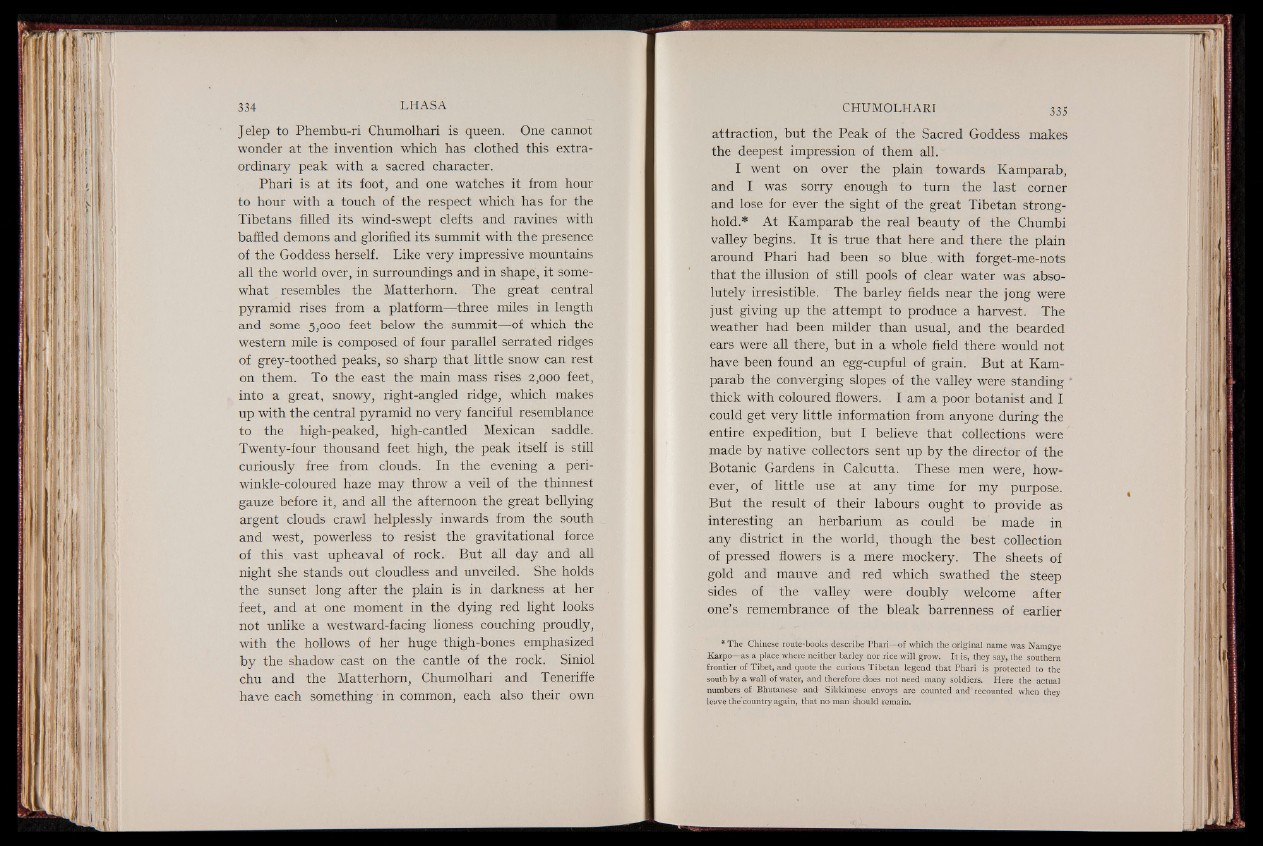
Jelep to Phembu-ri Chumolhari is queen. One cannot
wonder at the invention which has clothed this extraordinary
peak with a sacred character.
Phari is at its foot, and one watches it from hour
to hour with a touch of the respect which has for the
Tibetans filled its wind-swept clefts and ravines with
baffled demons and glorified its summit with the presence
of the Goddess herself. Like very impressive mountains
all the world over, in surroundings and in shape, it somewhat
resembles the Matterhorn. The great central
pyramid rises from a platform— three miles in length
and some 5,000 feet below the summit— of which the
western mile is composed of four parallel serrated ridges
of grey-toothed peaks, so sharp that little snow can rest
on them. To the east the main mass rises 2,000 feet,
into a great, snowy, right-angled ridge, which makes
up with the central pyramid no very fanciful resemblance
to the high-peaked, high-cantled Mexican saddle.
Twenty-four thousand feet high, the peak itself is still
curiously free from clouds. In the evening a peri-
winkle-coloured haze may throw a veil of the thinnest
gauze before it, and all the afternoon the great bellying
argent clouds crawl helplessly inwards from the south
and west, powerless to resist the gravitational force
of this, vast upheaval of rock. But all day and all
night she stands out cloudless and unveiled. She holds
the sunset long after the plain is in darkness at her
feet, and at one moment in the dying red light looks
not unlike a westward-facing lioness couching proudly,
with the hollows of her huge thigh-bones emphasized
by the shadow cast on the cantle of the rock. Siniol
chu and the Matterhorn, Chumolhari and Teneriffe
have each something in common, each also their own
attraction, but the Peak of the Sacred Goddess makes
the deepest impression of them all.
I went on over the plain towards Kamparab,
and I was sorry enough to turn the last corner
and lose for ever the sight of the great Tibetan stronghold.*
At Kamparab the real beauty of the Chumbi
valley begins. It is true that here and there the plain
around Phari had been so b lu e . with forget-me-nots
that the illusion of still pools of clear water was absolutely
irresistible. The barley fields near the jong were
just giving up the attempt to produce a harvest. The
weather had been milder than usual, and the bearded
ears were all there, but in a whole field there would not
have been found an egg-cupful of grain. But at Kamparab
the converging slopes of the valley were standing
thick with coloured flowers. I am a poor botanist and I
could get very little information from anyone during the
entire expedition, but I believe that collections were
made by native collectors sent up by the director of the
Botanic Gardens in Calcutta. These men were, however,
of little use at any time for my purpose.
But the result of their labours ought to provide as
interesting an herbarium as could be made in
any district in the world, though the best collection
of pressed flowers is a mere mockery. The sheets of
gold and mauve and red which swathed the steep
sides of the valley were doubly welcome after
one’s remembrance of the bleak barrenness of earlier
*The Chinese route-books describe Phari— of which the original name was Namgye
Karpo—as a place where neither barley nor rice will grow. It is, they say, the southern
frontier of Tibet, and quote the curious Tibetan legend that Phari is protected to the
south by a wall of water, and therefore does not need many soldiers. Here the actual
numbers of Bhutanese and Sikkimese envoys are counted and" recounted when they
leave the'country again, that no man should remain.